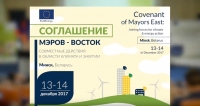Deadline for SEAP submission
Signatories to the Covenant of Mayors related to the 2020 framework, commit to submitting their Sustainable Energy Action Plans where the Covenant objectives and measures are justified within one year following the local council decision as indicated in the adhesion document.
Deadline for SECAP submission
Signatories to the Covenant of Mayors for Climate and Energy related to the 2030 framework commit to submitting their Sustainable Energy and Climate Plan, including justified objectives and actions within two years following the date of the local council decision as indicated in the adhesion document.
Can an already existing local climate and energy plan (SEAP) be sufficient to fulfil the requirements a SEAP/SECAP?
Written by Raphael ChateletIn order to make sure that your existing Action Plan fulfils the minimal requirements set in the context of the Covenant of Mayors, please review the document according to the 10 key principles for the energy and climate mitigation part (see in the SEAP Guidebook - en, de, fr, it & es, page 8).
The action plan must contain a clear reference to the core commitments, i.e.at least 20%. CO2 emissions reduction by 2020 and/or 30% CO2 emissions reduction by 2030 and increased resilience to the impacts of climate change (SECAP)taken by the local authority when signing the Covenant of Mayors.
The strategic commitments have to be translated into concrete actions in the short and medium term, as well as longer term strategies and goals. If your existing action plan has a shorter or a longer timeframe than the Covenant timeframes (i.e. 2020 or 2030), you have to adjust it to the Covenant target time horizons and include the Covenant target in your action plan approved by the City Council.
In addition, the key elements of your action plan have to be reported in the online template available in ‘My Covenant’. Please check the Reporting Guidelines available in the library.
Which sectors/fields of action are considered in a SEAP and in a SECAP?
Written by Raphael ChateletSince the Covenant's commitments concern the whole geographical area of the local authority, the action plan should include actions that cover the sectors of activity from both public and private actors.
Covenant signatories are free to choose their main areas of action. In principle, it is anticipated that most action plans will cover the sectors that are considered within the emission inventory and risk and vulnerability assessment (for SECAP only).
For the mitigation part (both SEAP and SECAP):
It is recommended to include actions targeting the Covenant key sectors:
- Municipal buildings, equipment/facilities;
- Tertiary (non-municipal) buildings, equipment/facilities;
- Residential buildings;
- Transport.
Actions can also be included for other sectors such as:
- Industry.
- Local electricity production.
- Local heat/cold production.
- Others (e.g. Agriculture, Forestry, Fisheries).
For the adaptation part (For SECAP only):
Identification of the sectors to increase the resilience in a city is highly contextual. A solid and comprehensive climate adaptation strategy therefore involves thinking adaptation into all aspects of municipal services affected by climate change. Some of the main sectors that can improve the resilience of cities include:
- Infrastructure.
- Public Services.
- Land Use Planning.
- Environment & Biodiversity.
- Agriculture & Forestry.
- Economy.
What is a Sustainable Energy Action Plan (SEAP) or Sustainable Energy and Climate Action Plan (SECAP)?
Written by Raphael ChateletSignatories of the former Covenant of Mayors addressing only energy and climate change mitigation have committed to prepare and implement a Sustainable Energy Action Plan (SEAP) before 2020. Signatories of the new Covenant of Mayors for Climate and Energy now commit to prepare and implement Sustainable Energy and Climate Action Plan (SECAP), addressing both climate mitigation and adaptation before 2030.
The action plan (both SEAP and SECAP) is the key document which shows how the Covenant signatory will reach its vision and target. The plan includes an assessment of the current situation, i.e. a Baseline Emission Inventory for the climate mitigation part (both SEAP and SECAP) and a Risk and Vulnerability Assessment for the adaptation part (For SECAP only); clearly identified goals and targets; and the measures planned together with time frames, assigned responsibilities and estimated impacts.
Scope of action:
The Covenant of Mayors concerns the action at local level within the competence of the local authorities involved. Hence, it is expected that the Covenant signatories will act in several or all of their possible roles:
● Consumer and model: All local authorities are responsible for their own energy consumption. At the same time, they play an exemplary role by encouraging citizens and other stakeholders to use energy more efficiently.
● Planner, developer and regulator: All local authorities are usually responsible for building, transport and land use planning policies. They have the power to: optimize the energy performance of new facilities, integrate sustainable transport measures and adaptation strategies in local planning practice. They shape transport/energy performance by legal decisions and regulatory instruments.
● Producer and supplier: Local authorities may also act as a local utility or service provider promoting local energy production and using renewable energy sources (e.g. Combined Heat and Power/CHPs, district heating systems etc.).
● Advisor and motivator: Awareness-raising activities are important to engage the whole community to support sustainable energy and climate policies. Local authorities can act as advisor and educator for citizens and other stakeholders (e.g. architects, planners or craftsmen).
For guidance on the mitigation part, please consult the SEAP Guidebook (en, de, fr, it & es)
For guidance on the adaptation part, please consult the Urban Adaptation Support Tool.
What is a Risk and Vulnerability Assessment?
Written by Raphael ChateletThe Risk and Vulnerability Assessment is an analysis that determines the nature and extent of risk, by analyzing potential hazards and assessing vulnerability that could pose a potential threat or harm to people, property, livelihoods and the environment on which they depend. It allows the identification of areas of critical concern and therefore provides information for decision-making. The assessment could address risks related to floods, extreme temperatures and heat waves, droughts and water scarcity, storms and other extreme weather events, increased forest fires, sea level rise and coastal erosion (if applicable). The Risk and Vulnerability Assessment serves, along with the Baseline Emission Inventory, as the point of departure for the development of the Sustainable Energy and Climate Action Plan.
Where to find support to prepare a Risk and Vulnerability Assessment (RVA)?
Written by Raphael ChateletThe Urban Adaptation Support Tool provides a detailed step-by-step guide to developing a Risk and Vulnerability Assessment. The guide furthermore provides support in utilizing the RVA and translating the findings into adaptation measures. You can find the Urban Adaptation Support Tool here.
More...
Irina Plis is a co-founder and an Executive Director of a Moldova NGO Alliance for Energy Efficiency and Renewables (AEER) with over 20 years of experience in developing, promoting and implementing different donor-funded projects in energy and environment. Since 2012 Ms Plis has been providing tailored support to municipalities on the development of SECAPs, capacity building, networking with financing institutions and local stakeholders, public awareness and communication. Since 2014 Ms Plis developed and managed the implementation of complex and innovative energy projects to improve the municipal infrastructure including public buildings, street lighting, use of RES, municipal services with the total attracted budget of over 3 mln. Euros.
Additional Info
- Имя Irina Plis
- Должность Country Expert for Moldova
- Телефон +373 22 20 00 90
- Email This email address is being protected from spambots. You need JavaScript enabled to view it.
Christophe Fréring has over 30 years of professional experience in project management with more than 20 years in the field of sustainable energy and 12 years working in the Eastern Partnership region. Mr Fréring has been coordinating the Covenant of Mayors East Office on behalf of the European Commission since 2011.
Additional Info
- Имя Christophe Fréring
- Должность Team Leader
- Телефон +38 044 278 03 13
- Email This email address is being protected from spambots. You need JavaScript enabled to view it.








